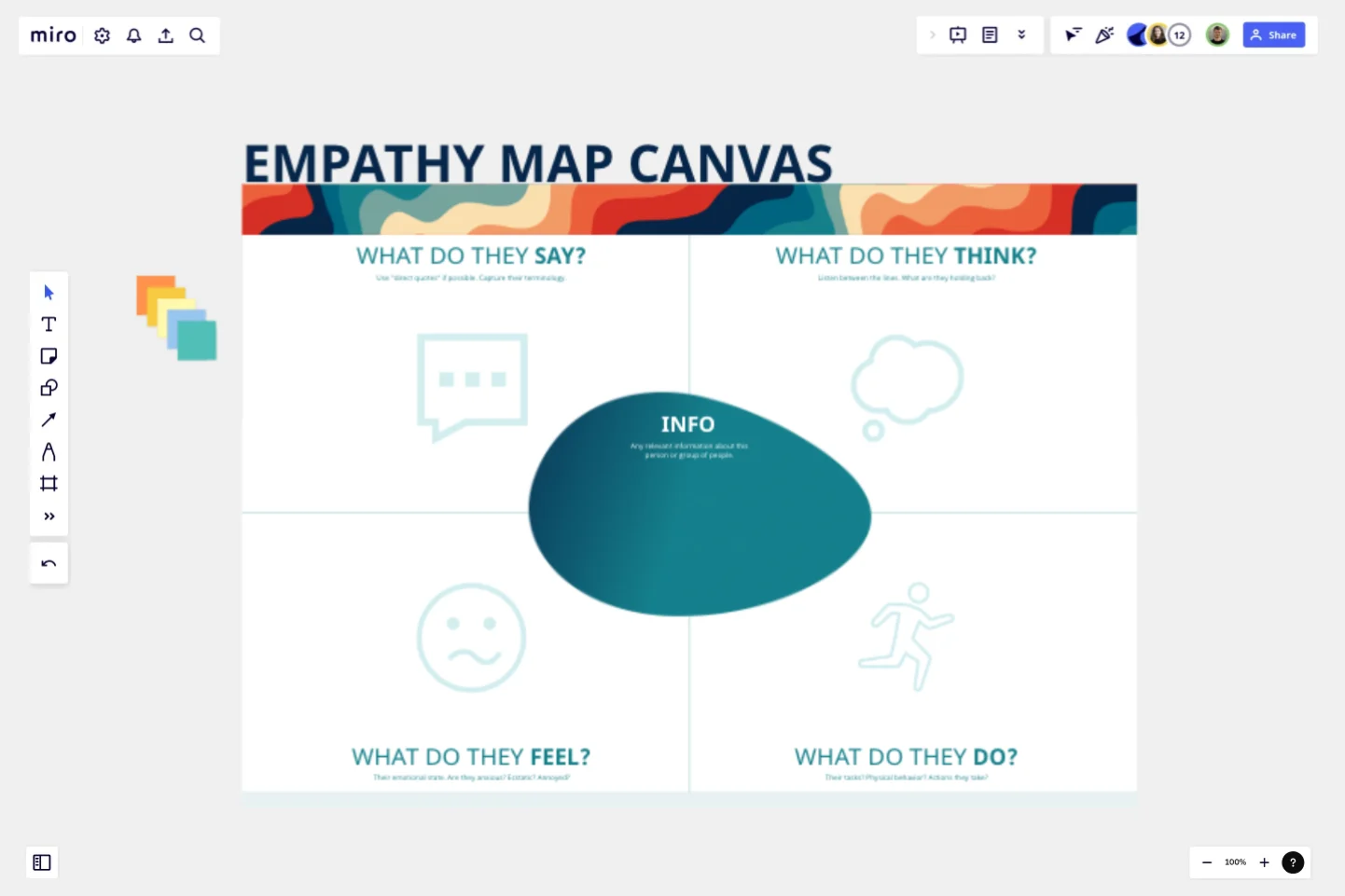Empathy Map Canvas
In order to create products that truly work for people, we need to first empathize with them...to walk a mile in their shoes...to understand what makes them tick and what ticks them off.
The Empathy Map allows us to experience things from our customers' perspective. This exercise goes well beyond their surface needs (what they say they want) and digs into the latent needs as well as the emotional triggers that drive their behavior and impact the decisions they make.You can build an individual Empathy Map for each person you conduct research with or you can combine multiple people into one, persona-like Empathy Map.
WHY DO IT?
Generate a solid foundation of understanding/empathy for your customers
Garner alignment among your team
Find themes and generate insights for future ideation
Help your core team socialize "Voice of the Customer" outward to stakeholders
Reduce personal bias from your designs
Reveal latent needs that your customers are not aware they have
WORKSHOP PREPARATION:
Works best with 2-4 People
Time: 1-2 hrs depending amount of data & number of maps you're creating
Supplies: This Miro board, an open mind, and some humility!
WORKSHOP FLOW:
1. Start with the data. It could be:
Notes from customer interviews
Feedback gathered from your customer experience team
Observations from watching people interact with you product
Any way you can get first-hand input from customers
2. Add sticky notes to the board:
Break that data down into one thought or concept per sticky note
Place them on the board wherever they make the most sense. Keep in mind that some notes could easily live in more than one spot. Don't sweat it...make a quick decision and keep moving
Everyone should work alone until all notes are arranged on the board
3. Open discussion:
Review the notes and think out loud to spur deeper discussion
Ask questions or challenge placement
Identify gaps in understanding—what else do you need to learn?
What Are We Capturing?
CONTEXT / INFO: Any relevant information about this person or group of people.
WHAT DO THEY SAY? Use "direct quotes" if possible. Capture their terminology.
WHAT DO THEY THINK? Listen between the lines. What are they holding back?
WHAT DO THEY FEEL? Their emotional state. Are they anxious? Ecstatic? Annoyed?
WHAT DO THEY DO? Their tasks? Physical behavior? Actions they take?
THEIR GOALS? What do they want to accomplish? Their 'Jobs To Be Done'?
THEIR PAINS? What frustrates them? What is getting in their way?
ADAPT:
I encourage you to consider how you might add to, or alter, this exercise. Your situation is likely unique. Can you start with your existing personas in the middle? Could you make this entire map centered around uncovering insights for one feature you're experimenting with? Could you add a narrative section to capture a story from each person?The sky is the limit...have some fun and try something new!
This template was created by Pete Fleming.
Get started with this template right now.
Remote Design Sprint Template
Works best for:
Design, Desk Research, Sprint Planning
A design sprint is an intensive process of designing, iterating, and testing a prototype over a 4 or 5 day period. Design sprints are conducted to break out of stal, work processes, find a fresh perspective, identify problems in a unique way, and rapidly develop solutions. Developed by Google, design sprints were created to enable teams to align on a specific problem, generate multiple solutions, create and test prototypes, and get feedback from users in a short period of time. This template was originally created by JustMad, a business-driven design consultancy, and has been leveraged by distributed teams worldwide.
Empathy Map Pro
Works best for:
Market Research, Research & Design
Empathy Map Pro helps you dive deeper into understanding your users. By exploring their thoughts, feelings, and experiences, you can create more effective solutions tailored to their needs. This advanced template is perfect for product development teams aiming to enhance user satisfaction and drive innovation.
Service Experience Observation Sheet
Works best for:
Research & Design
The Expanded Service Blueprint provides a detailed view of your service processes and interactions. This template is ideal for comprehensive service analysis and improvement. Use it to align teams, visualize the customer journey, and identify opportunities for optimization. It's perfect for enhancing service delivery, fostering collaboration, and ensuring a seamless and efficient service experience for your customers.
Journey Map To Plot the Customer Experience
Works best for:
Customer Journey Map
A journey is a tool to map out the customer experience of (a part of) your product/service in a visual way.
User Empathy Map
Works best for:
Market Research, Research & Design
User Empathy Map template helps you visualize user experiences and needs. It’s an essential tool for teams looking to design products that resonate with their users. Use this template to build empathy and improve user satisfaction.
Empathy Mapping by ServiceNow
Works best for:
Research & Design, Market Research
The Empathy Mapping template helps teams capture detailed user insights. By understanding user perspectives, you can improve product features and customer satisfaction. This template is perfect for user research and product development.
